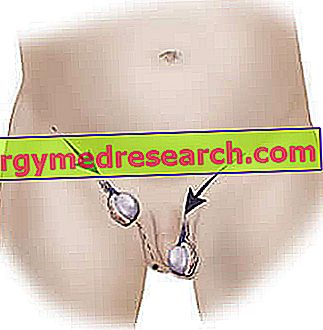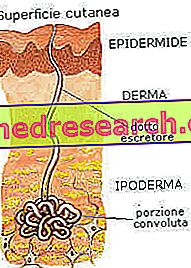Generality
The orchidopexy is the surgical procedure used to resolve cases of cryptorchidism.

Orchidopexy intervention.
From: www.betterhealth.vic.gov.au
Cryptorchidism, or "testicle / s believed", is that condition in which one or both testicles are still found between the abdomen and inguinal canal; in other words, they are not descended into the scrotum, as normally happens within the first months of the child's life.
The orchidopexy requires a particular preparation, such as the execution of some clinical tests (blood tests, urine tests, etc.) and the appearance, on the day of the operation, of fasting for at least 8 hours.
Doctors can perform the orchidopexy procedure in two distinct ways: through a traditional surgery or laparoscopy approach.
Except in rare circumstances, the results at the end of the operation are more than satisfactory.
The risk of complications is low.
Anatomical and functional recall on the testicles
In number of two, the testicles (or didymas ) represent the male gonads .
The gonads are the reproductive organs that produce sex cells, also known as gametes. The male gametes are spermatozoa, so the first task of the testicles is to give rise to spermatozoa ( spermatogenesis ).
The amount of spermatozoa that a healthy male's testicles releases over a lifetime is enormous.

Size and weight of the testicles in the adult male:
- 3.5-4 cm long
- 2.5 cm wide
- 3 cm anteroposterior diameter
- About 20 grams of weight
The second task of didymas - no less important than the first - is to produce male sex hormones (or androgens). The main representative of androgens is testosterone .
The testicles reside inside a sac, called the scrotum, which is located under the penis.
Their housing inside the scrotum generally occurs one or two months before birth. Before that, they are confined to a region of the abdomen.
Sometimes, it may happen that the process of "descent" of the testicles occurs after birth, during the first six months of life.
What is the orchidopexy?
The orchidopexy is the surgical intervention aimed at people suffering from cryptorchidism, for the arrangement of the testicles inside the scrotum.
WHAT IS CRYPTORISM?
The doctors talk about cryptorchidism (or testicle / s ), when the testicles did not descend from the abdomen towards the scrotum, according to that natural process to which the introduction referred.
Therefore, an individual suffering from cryptorchidism has one or both testicles in the abdominal area or in the inguinal canal (that is the conduit that connects the abdomen to the scrotum and through which the didymas usually pass during the descent process).
Cryptorchidism is the most common anomaly of the urogenital apparatus of newborns and male infants.
According to some statistical surveys, it would concern one newborn male child every 25, therefore 4% of male births.
Most cases of testicles / i believed to heal spontaneously during the first months of life (spontaneous resolution). Those in whom the problem persists - estimates speak of one case every 100 - need the help of the doctor and a specific treatment, precisely the orchidopexy.
The doctors have not yet identified the precise causes of cryptorchidism, however they have found the existence of a correlation between the lack of descent of the testicles in the scrotum and some situations such as:
- Premature birth. Particularly at risk are children born before the 37th week of pregnancy.
- Low birth weight
- Family history of cryptorchidism
60-65% of cases of cryptorchidism involve only one testicle ( unilateral cryptorchidism ); the remaining percentage is due to bilateral cryptorchidism, ie involving both testicles.
Origin of the term criptorchidism
The term criptorchidism derives from the union of two Greek words: "cripto" (κρυπτος), which means "hidden" and "orchis" (όρχυς ‚), which means testicle.
Thus, the literal meaning of cryptorchidism is hidden testicle.

Figure: various types of cryptorchidism.
When you run
The medical condition that requires the intervention of orchid patients has already been widely discussed. So the point that remains to be clarified is: why is it important to solve cryptorchidism?
Before discussing this topic, it should be remembered that, according to the doctors, the best time to testicle is deemed to be between 9 and 15 months.
However, there are particular cases, often the result of an unexpected anatomical modification of the genitals, for which the intervention takes place decidedly later, for example during childhood, adolescence or adulthood.
IMPORTANCE OF TREATING CRYPTORCHISM
After various studies and the examination of numerous clinical cases, doctors claim that it is good to treat cryptorchidism early because:
- With its resolution, the testes or testes involved work better.
- Cryptorchidism is the most important factor favoring testicular cancer. According to the latest statistical research, it seems that the carriers of a testicle believed to be 10 to 40 times more at risk, compared to normal males, of developing a testicular neoplasm.
Moreover, again from the same research, it emerged that 10% of seminomas (NB: seminoma is the most common testicular cancer) is associated with a previous history of failure to descend one or both testicles.
- Failure to descend one or both testicles tends to favor the appearance of inguinal hernias.
- The permanence of the testicles in the abdomen, at a later age, represents a danger during sports where physical contact is foreseen (football, rugby, etc.); furthermore it is annoying when the person carrying the anomaly uses the safety belt and wears some particular clothes.
- The anomalous appearance of the scrotum of the carriers can influence the individual psychological sphere. Often, subjects treated at a later age than usual develop a sort of depression, due to the fact that they feel different from their healthy peers.
THE ORCHIDOPESSI IN ADVANCED AGE
Some men may suffer from retractile testicle suddenly and without explanation. This particular condition - which can occur at any age, but especially during childhood - consists in the ascent of one or both testicles from the scrotum towards the groin, through the inguinal canal.
Often, the retractile testicle heals spontaneously, without any treatment; however, when this is not the case, the only possible solution to solve the problem is the intervention of orchid patients.
Preparation
Premise: since most of the interventions of orchidopexes see very young children as protagonists, in this and in the next chapters the content of the texts will mainly concern the operation on subjects of a few months of life.
Before the orchidopexy, the doctor must subject the small patient to various clinical tests (blood tests, urine tests, electrocardiograms etc.), to make sure that there are no contraindications to surgical practice.
After that, he meets his parents and informs them about pre-operative measures.
Among these, the most important, which deserves a special mention, is the observance of complete fasting on the day of the procedure. In fact, since general anesthesia is provided, before the intervention takes place the mother must not feed her child for a certain number of hours. The decision on when fasting should begin (so how long the patient should not take food) is solely up to the attending physician.
Failure to comply with this pre-operative measure implies the cancellation of the procedure.
IF THE PATIENT HAS SOME YEARS MORE
When patients are children of 5-6 years (or in general older individuals), doctors use the help of parents to find out if their children have suffered from particular illnesses in the past, allergic reactions to drugs, etc.
Procedure
There are various ways (or approaches) to execute an orchidopexy.
In general, the choice of approach depends on the position of the testicle (s) retained.
- Cryptorchidism based in the inguinal region .
In these situations, the attending physician opts for a traditional surgical approach and performs two incisions: one in the groin and another in the scrotum. Through the inguinal incision, mobilization of the retained testicle takes place; while, through the scrotal incision, it provides for the correct housing of the testicle inside the scrotum.
At the end of this phase, apply stitches on the incisions, to promote skin healing. In general, the sutures are absorbable.
- Cryptorchidism with abdominal site .
In these situations, the treating physician opts for a minimally invasive surgical approach, known as laparoscopy, which involves performing two or three mini-incisions on the abdomen. Through these small openings, he inserts various instruments (laparoscope, forceps, etc.), which he uses to place the retained testicles inside the scrotum.
As before, after arranging the didymas in their rightful place, it closes the incisions with stitches.
The advantage of laparoscopy is that the incisions are very small and heal much more quickly than traditional incisions.
From the operational point of view, the surgical treatment of cryptorchidism with inguinal site is simpler, compared to the surgical treatment of cryptorchidism with abdominal site.
The reason is very simple: in the first condition, the testicles are closer to the scrotum, so their arrangement is less complex.
WHAT IS THE GENERAL ANESTHESIA?
General anesthesia means that the patient sleeps and is completely unconscious during the entire procedure.
To administer anesthetic drugs by venous or inhalation (NB: the administration of these drugs lasts until the conclusion of the operation), is a doctor specialized in anesthesia practices (ie an anesthesiologist).
Generally, the anesthetic works within 10-15 minutes. Only after falling asleep, the attending physician has the go-ahead to begin treatment.
For the duration of the anesthesia, the patient remains connected to a series of instruments that measure his heart rate, his blood pressure, his body temperature and his oxygen level in the blood. In this way, there is a continuous monitoring of its vital parameters and an immediate and real-time feedback of any minimum variation.
WHO IS THE INTERVENTION?
To perform the orchidopexy is generally a pediatric surgeon or a pediatric urologist.
After the surgery
After the orchidopexy, a hospitalization of about 24 hours is foreseen.
During this time, medical personnel monitor the patient's vital parameters (blood pressure, cardiac activity, etc.) and explain to parents the various stages of recovery and the most important post-operative recommendations.
POST-OPERATIVE SENSATIONS
It is quite normal that, after the orchidopexy, patients warn:
- Pain at the level of the operated area. In general, this sensation is resolved in a few days. In very young children, the alleviation of pain coincides with an improvement in their mood.
- Confusion and stunning. They are effects due to general anesthesia. They are solved within 24 hours.
- Feeling tired. It gradually disappears in a few days.
POST-OPERATION RECOMMENDATIONS
The most important post-operative recommendations include:
- Allow the child to drink plenty of water, several times a day, to help eliminate the anesthetics administered for the operation.
- Prefer to wash the body in pieces compared to the shower. Avoid using the bathtub. Failure to comply with this recommendation could be problematic for the sutures, which could become detached earlier than expected.
- Initially, give lots of small meals. The return to fewer meals, but more substantial, can take place a few days after the intervention.
- Allow the child to wear comfortable underwear. Some doctors also recommend a diaper because it offers good protection.
- In the case of children aged 4-5 years and up, keep them at rest for a few weeks from any sporting activity and from other dangerous pastimes (for example the bicycle).
For the first few days, it is also good that they stay home from school.
Risks and complications
Orchidopexy is now a fairly safe operation.
However, since it is still a surgery of some importance, it has a small risk margin and the possibility of giving complications.
Possible complications of the orchidopexy:
- Blood loss, swelling and bruising at the surgical incisions.
- Infections
- Testicle ascent to the same point where it was housed before the operation
- Testicular atrophy
- Damage at the level of the vas deferens, ie the tubular-shaped elements that join the testicle to the urethra and through which the spermatozoa flow.
Results
The results depend largely on the site of the testicles.
If the didymons reside at the inguinal level, the success rate of the orchidopexy exceeds 90%; if instead they are lodged in the abdomen, it takes on lower values.



